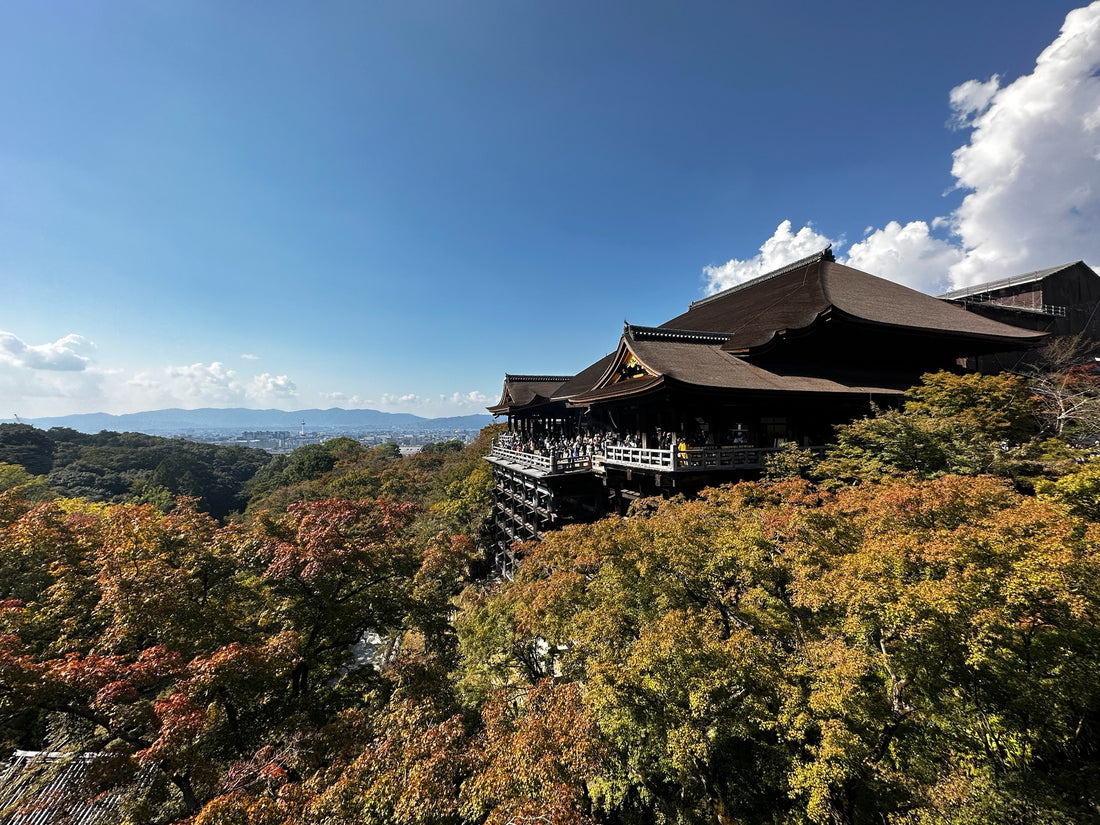"Discovering Japan: A Journey through Tokyo, Kyoto, and Osaka"
Introduction: Embracing the Essence of Japan
Japan, a country where ancient traditions seamlessly blend with cutting-edge technology, is a traveler's paradise. In this travel blog, we embark on a captivating journey through three of Japan's most vibrant cities: Tokyo, Kyoto, and Osaka. Each city offers a unique glimpse into Japan's rich cultural tapestry, providing a harmonious mix of modernity and tradition.
Tokyo: The Futuristic Metropolis

Our adventure begins in Tokyo, a city pulsating with energy and innovation. Skyscrapers pierce the sky, neon lights illuminate the streets, and the bustling crowds create a symphony of urban life. First on the list, Tokyo Skytree.

Tokyo Skytree, a towering landmark in the heart of Tokyo, Japan, stands as an architectural marvel and a symbol of modern innovation. Soaring to a height of 634 meters, it is the tallest structure in Japan and an iconic presence on the city's skyline. The tower's sleek and intricate design seamlessly blends traditional Japanese aesthetics with contemporary elements, creating a visually striking structure. Visitors are treated to unparalleled panoramic views of Tokyo and its surroundings from the observation decks, offering a breathtaking perspective of the bustling metropolis. Tokyo Skytree not only serves as a premier broadcasting facility but also houses a vibrant shopping and entertainment complex at its base, making it a must-visit destination for both locals and tourists seeking a captivating blend of culture and technology. Next up for awesome bites and eats, we stop at Tsukiji Fish Market.


Tsukiji Fish Market, located in Tokyo, was once renowned as the world's largest and busiest fish market. Although the wholesale market moved to Toyosu in 2018, Tsukiji remains a vibrant destination for seafood enthusiasts. The outer market, Tsukiji's bustling section, is a haven for fresh seafood, sushi, and traditional Japanese culinary delights. Visitors can explore a myriad of stalls offering an array of fresh fish, sashimi, sushi, and street food. The lively atmosphere, coupled with the distinct aroma of the ocean, creates an authentic and memorable experience for those seeking a taste of Tokyo's rich culinary culture. Next stop, Asakusa.

For a taste of traditional Japan in Tokyo, we explore Asakusa and its iconic Senso-ji Temple. Sensoji Temple, nestled in the heart of Asakusa, Tokyo, is a cultural gem and the oldest Buddhist temple in the city. Steeped in history, the temple's vibrant Thunder Gate, or Kaminarimon, welcomes visitors with its colossal red lantern. Beyond the gate lies Nakamise-dori, a bustling shopping street adorned with traditional stalls, leading pilgrims and tourists to the main hall of Sensoji. The temple's five-story pagoda and the serene Asakusa Shrine complement the serene ambiance, offering a peaceful escape amidst the dynamic urban landscape of Tokyo. Sensoji Temple stands as a testament to Japan's rich cultural heritage, inviting exploration and reflection in its hallowed grounds. Next up, world famous Mount Fuji.

Mount Fuji, an iconic symbol of Japan, is an awe-inspiring stratovolcano that stands at 3,776 meters (12,389 feet) tall. Located near Tokyo and Yokohama, it is the highest peak in Japan and an integral part of the country's cultural heritage. Mount Fuji's near-perfect conical shape, capped with snow during the colder months, has inspired artists and poets for centuries. The mountain is a UNESCO World Heritage Site and attracts millions of visitors each year who come to admire its beauty, hike its trails, and capture breathtaking views of the surrounding landscapes. Mount Fuji holds a significant place in Japanese history and mythology, often depicted in traditional art and literature as a symbol of endurance, beauty, and tranquility.

As night falls, we venture to the trendy districts of Shinjuku and Roppongi. Tokyo's nightlife is a kaleidoscope of karaoke bars, izakayas, and futuristic theme cafes. Don't forget to experience a capsule hotel for a uniquely Japanese accommodation experience!
Kyoto: A Glimpse into Japan's Past
Next, we board the Shinkansen and head to Kyoto, a city steeped in history and cultural richness. Kyoto's charm lies in its well-preserved temples, traditional tea houses, and enchanting gardens. Our first stop is the Hanamikoji Street.

Hanamikoji Street, nestled in the Gion district of Kyoto, is a captivating thoroughfare that exudes the charm of traditional Japan. Lined with preserved wooden machiya houses, this historic street offers a glimpse into the world of geishas and maikos. Walking along Hanamikoji Street, visitors can discover quaint teahouses, exclusive restaurants, and traditional ryokans, creating an authentic atmosphere reminiscent of Kyoto's cultural heritage. During the evening, the softly lit lanterns cast a magical glow, enhancing the street's allure and making it a popular destination for those seeking a nostalgic and picturesque experience in the heart of Kyoto. Next stop, Yasaka Shrine.


Yasaka Shrine, situated in the Gion district of Kyoto, is a sacred haven that weaves spirituality into the fabric of traditional Japanese culture. Dating back to the 7th century, the shrine, also known as Gion Shrine, stands at the eastern end of Shijo-dori, welcoming both locals and visitors with its iconic vermilion gates. The main hall and lantern-adorned pathways create a serene ambiance, offering a peaceful retreat in the midst of Kyoto's bustling cityscape. Next up, Arashiyama district to see the bamboo forest.

The Arashiyama Bamboo Grove in Kyoto is a mesmerizing natural wonder, enchanting visitors with its towering bamboo stalks that create a serene and ethereal atmosphere. Located in the scenic Arashiyama district, the bamboo forest provides a tranquil escape from the urban hustle. As sunlight filters through the dense bamboo canopy, casting a play of shadows on the forest floor, visitors are immersed in a surreal landscape that evokes a sense of tranquility and wonder. The enchanting pathway through the bamboo grove leads to the iconic Nonomiya Shrine, adding a touch of spiritual significance to this captivating natural spectacle. Exploring the Arashiyama Bamboo Grove is a sensory journey that showcases the delicate harmony between nature and culture in Kyoto. Next, the iconic Fushimi Inari Taisha.


Fushimi Inari Taisha, located in southern Kyoto, is an iconic Shinto shrine renowned for its mesmerizing pathway lined with thousands of vibrant red torii gates. Dedicated to Inari, the Shinto god of rice and prosperity, the shrine's unique and picturesque entrance, known as the Senbon Torii, invites visitors on a mystical journey up the sacred Mount Inari. The trail leads to various smaller shrines and panoramic viewpoints, creating a spiritual and enchanting experience. Fushimi Inari Taisha is not only a place of worship but also a testament to the rich cultural and natural tapestry of Kyoto, offering a blend of spirituality, history, and breathtaking scenery. Next up, the dazzling Kinkaku-ji temple.

Kinkaku-ji, also known as the Golden Pavilion, is a dazzling Zen Buddhist temple nestled amidst lush gardens in Kyoto, Japan. The striking three-story structure is covered in gold leaf, creating a shimmering reflection on the tranquil pond that surrounds it. Originally built in the 14th century as a retirement villa for a shogun, the temple was later converted into a Zen temple. Kinkaku-ji's reflective beauty and harmonious integration with its natural surroundings make it a UNESCO World Heritage Site and a serene destination for contemplation and appreciation of Japan's cultural heritage. For some mouth-watering ramen, try your local ramen shop in Gion, Kyoto.

On to our final stop, Osaka!
Osaka: Culinary Delights and Urban Excitement
Our journey concludes in Osaka, a city renowned for its culinary prowess and lively atmosphere. Osaka Castle stands as a testament to the city's historical significance, surrounded by picturesque parks and cherry blossoms in season.

Osaka Castle stands as a majestic symbol of history and resilience in the heart of Osaka, Japan. Originally constructed in the 16th century, the castle has undergone reconstructions over the years and now boasts a stunning blend of traditional and modern architectural elements. Surrounded by expansive moats and lush gardens, Osaka Castle offers a glimpse into Japan's feudal past. Visitors can explore the castle's interior, which houses a museum showcasing artifacts and exhibits related to the castle's history. The observation deck provides panoramic views of Osaka, making it a compelling destination for both history enthusiasts and those seeking scenic beauty in the heart of the city. Even so, Osaka is considered to be the most western influenced and progressive city in Japan. We glimpse into a more artistic side of Japan; our last stop, is the busy and lively Dontonbori.

Dotonbori is a vibrant district in Osaka, Japan, renowned for its energetic atmosphere, neon-lit streets, and diverse culinary scene. Situated along the Dotonbori Canal, the area is adorned with iconic illuminated signs, including the famous Glico Running Man and the Kani Doraku Crab. Dotonbori is a hub for entertainment, shopping, and dining, offering a plethora of street food stalls, traditional restaurants, and modern entertainment establishments. The district comes alive at night, with the reflection of lights shimmering on the water, creating a lively and dynamic environment that captures the essence of Osaka's urban excitement.
Conclusion: Japan's Timeless Allure
Japan's allure lies in its ability to seamlessly blend the ancient with the modern, the traditional with the cutting-edge. Tokyo, Kyoto, and Osaka, each with its distinct personality, contribute to the kaleidoscope of experiences that make Japan an unforgettable destination. As our journey through these cities comes to an end, we carry with us the memories of spectacular views of nature, vibrant street markets, and the warm hospitality that defines Japan's unique charm. Arigato, Japan, for an extraordinary adventure!

